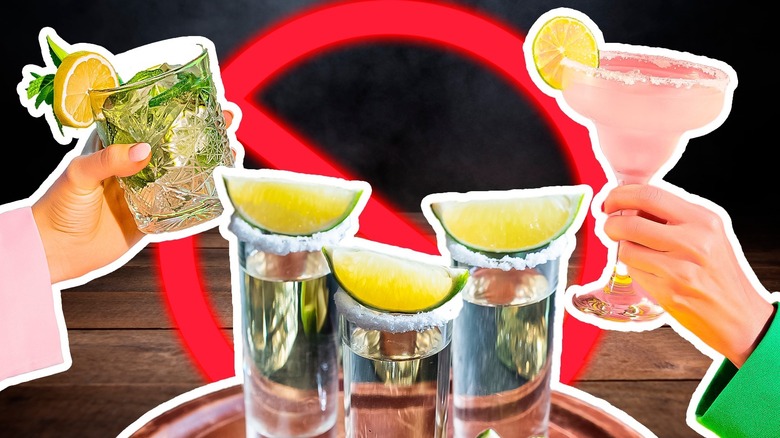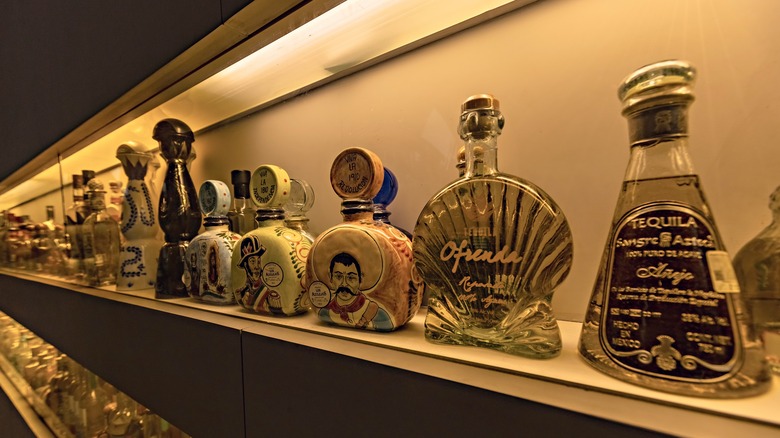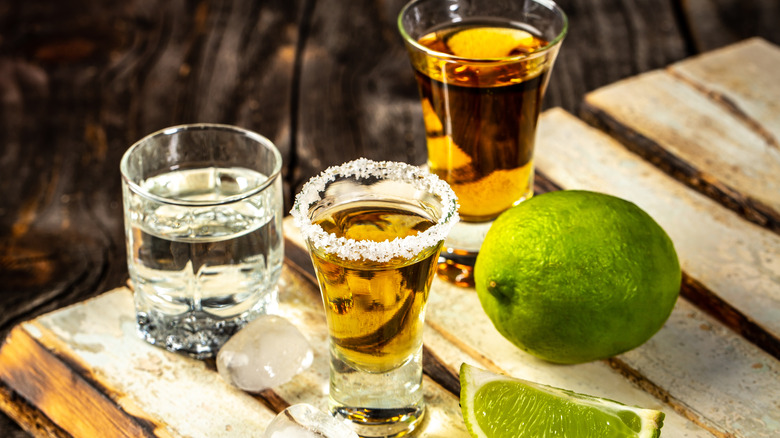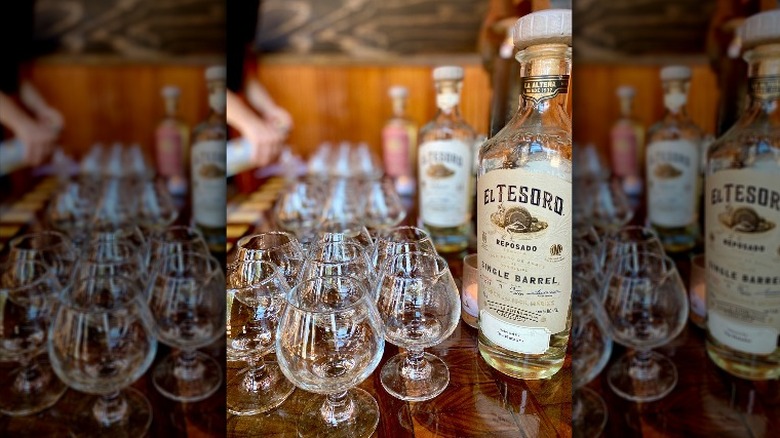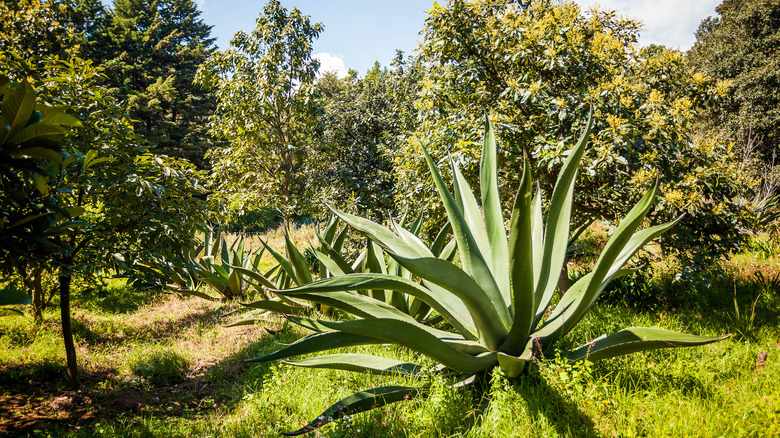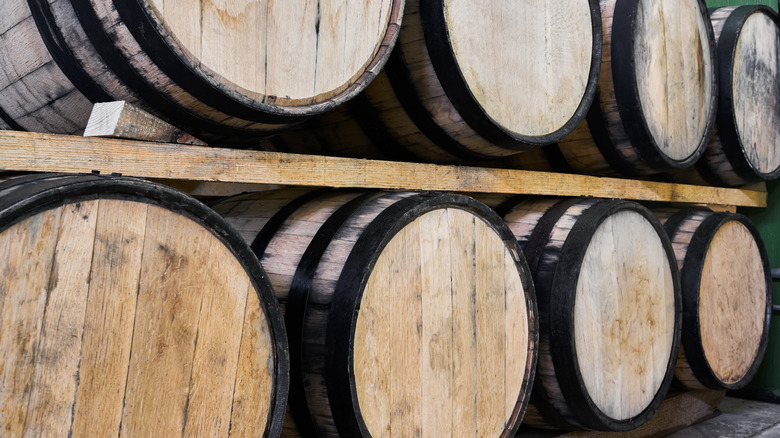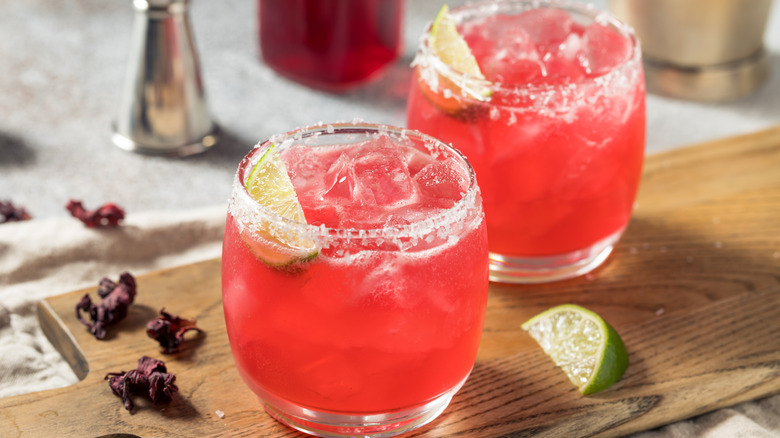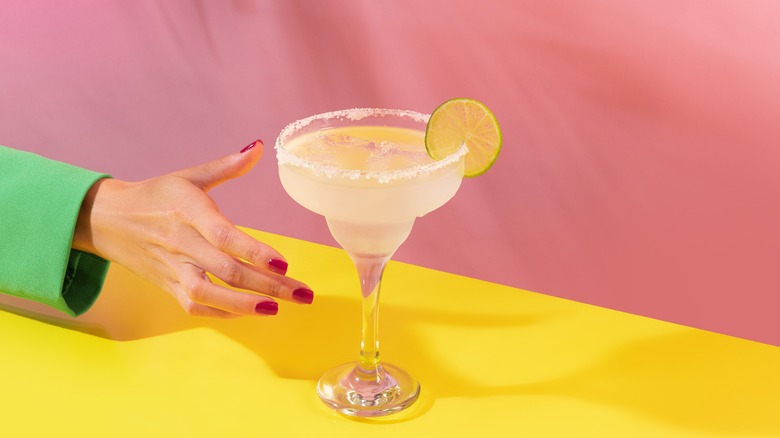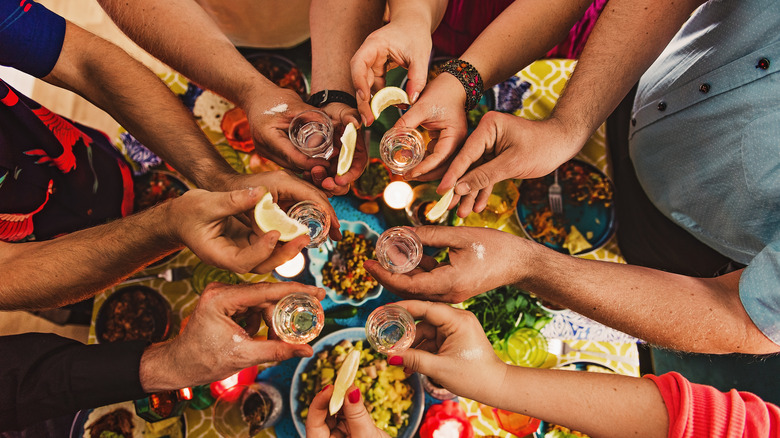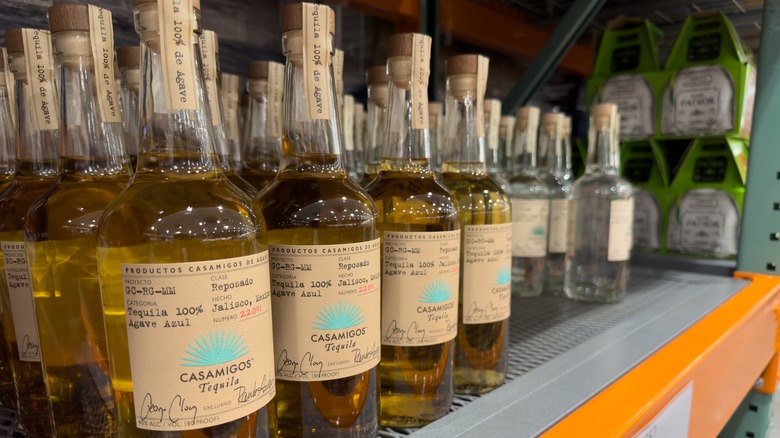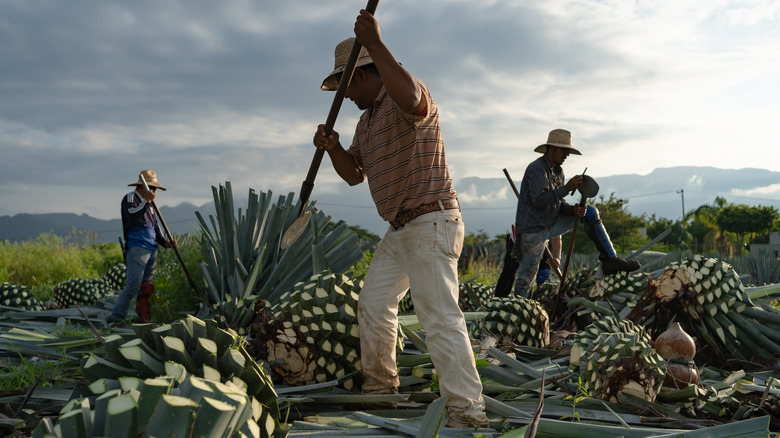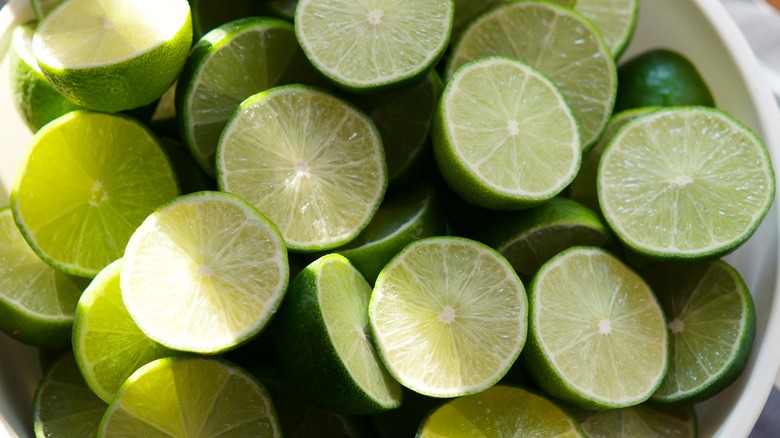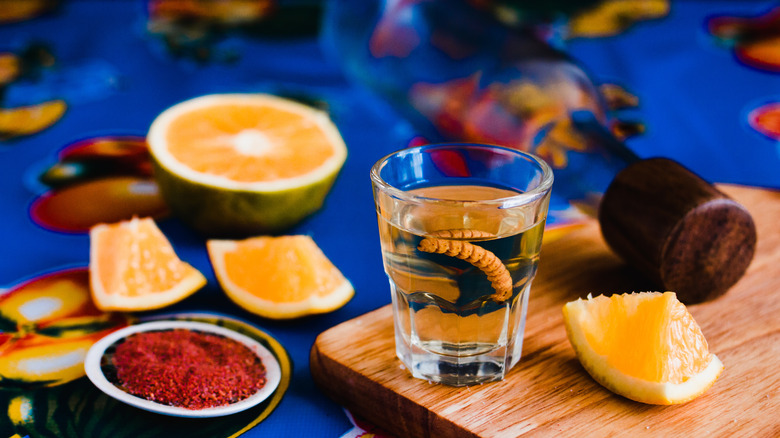12 Mistakes Everyone Makes With Tequila
There's a good reason why the global tequila market was worth US$14.7 billion in 2022, and is projected to hit a staggering $30.3 billion by 2028 (via IMARC Group). Tequila has transcended its Mexican roots, gaining substantial international acclaim. Over the years, the spirit has become a staple in many bars and restaurants worldwide, captivating consumers with its distinctive flavor. Tequila is also gradually shedding its reputation as the main ingredient in party shots and overly sweet margarita mixes. Instead, many are starting to recognize tequila's many variants as a sophisticated liquor that's a pleasure to sip.
Tequila production is regulated by Mexico's Tequila Regulatory Council, which was established in 1994 to oversee that the spirit adheres to a set of standardized practices. Under current legislation, tequila must be produced using a minimum of 51% blue Weber agave, with tequilas containing less than 100% agave categorized as mixto. In addition, tequila must contain between 35 and 55% alcohol by volume.
Tequila became the intellectual property of Mexico in 1974, which means "tequila" made in other countries can't be sold under that name, even if they cultivate agave. In addition, it can only be produced in some regions of Mexico, including the Mexican state of Jalisco, which is home to the liquor's namesake, the town of Tequila. The agave nectar can also be made in the Mexican states of Guanajuato, Michoacán, Nayarit, or Tamaulipas.
1. Confusing tequila with mezcal
While both tequila and mezcal are distilled from the agave plant, they possess very different characteristics. While mezcal can be made from around 50 different varieties of the agave plant, tequila has to be made specifically from blue Weber agave. This means that tequila is just one of the many different mezcal variants, which have a wide range of flavor profiles.
The two spirits are also distilled in different ways. Tequila is typically produced by cooking the piña, or agave core, in brick ovens, whereas mezcal production involves cooking the piña in underground pits lined with wood, charcoal, and sometimes even volcanic rocks. This distinctive production method is what gives mezcal its characteristic smoky flavor. In addition, once cooked, the piña for tequila is distilled in copper pots while the piña for mezcal is distilled in clay pots. While both spirits are aged following distillation, tequila is sometimes aged for longer than mezcal to imbue it with flavor.
Tequila and mezcal are also produced in different regions of Mexico. Tequila production is usually centered in Jalisco, Michoacán, Nayarit, Guanajuato, and Tamaulipas. Meanwhile, the main areas of mezcal production include Durango, Oaxaca, Guerrero, San Luis Potosí, and Zacatecas.
2. Not learning about the different types of tequila
While all tequila is made from the piñas of the blue Weber agave, the spirit can differ in taste and color depending on the length and specifics of its maturation process. There are four main categories of tequila. Firstly, there's blanco tequila, or silver tequila, which can be aged for up to 60 days, but is usually bottled immediately following the distillation process. It's transparent in color and relatively sharp in flavor, making it well-suited for cocktails. Secondly, there's reposado tequila, which is aged in barrels between two months and a year, and is smoother than blanco tequila. Thirdly, there's añejo tequila, which is aged for up to a year, allowing it to absorb some barrel notes. Finally, there's extra añejo tequila, which is aged for a minimum of three years, and has the most complex aromas and flavors.
In addition to the main four variants, tequila can also be classified as joven tequila or cristalino tequila. Joven tequila, or gold tequila, combines blanco tequila with a modest amount of aged tequila. It also usually contains additional ingredients such as caramel color, sugar syrup, oak extract, and glycerin. Meanwhile, cristalino tequila is an aged tequila (añejo or extra añejo) that has been filtered to remove its color, resulting in a flavorful transparent expression with a smooth, floral quality.
3. Not taking the time to appreciate straight tequila
When it comes to tequila, it's important to understand that each variant possesses its own unique flavor profile. While many of us shoot tequila with a little salt and a wedge of lime, this isn't how good tequila is meant to be drunk, and certainly won't give you the best picture of the liquor's flavor profile. The best way to savor and appreciate the distinct characteristics of different tequilas is to sip them just like it's been done in Mexico for centuries. And if you want to relish the spirit in a true Mexican fashion — and happen to find yourself in a reputable tequila bar — try chasing the spirit with sangrita, a palate cleanser that blends citrus juice with hot sauce.
To fully appreciate the spirit's intricate flavors and aromas, serve it at 69 degrees Fahrenheit rather than over ice. To get the most out of the experience, savor tequila from a stemmed or unstemmed tulip-shaped glass. This is because the glass' large middle captures the aromas while the tapered top intensifies them. Before sniffing the aromas, tilt the glass to ensure that the liquor is close to the rim. After taking each sip, inhale the liquor's aroma through your nose before swallowing it.
4. Misunderstanding the spirit's history
While many in the U.S. still view tequila as a cheap and fast way to start a party or conclude a night out, the spirit isn't just complex but comes with a long and storied history. Tequila's beginnings go back thousands of years, originating with the Aztecs who transformed the sap of maguey plants — a type of agave — into a milky beverage called pulque. In fact, the fermented elixir was so revered by the Aztecs that it became an integral part of their religious practices. There were two pivotal deities associated with the liquor, including the goddess of the maguey plant, Mayahuel, and the god of pulque, Patecatl.
The story of tequila picked up momentum after the Spanish invaded Mexico in the 16th century. After experimentations, the conquistadores started distilling fermented agave into "vino de mezcal." Alcohol made from agave in the area of Tequila started becoming popular in the 17th century. This is also when the Marquis of Altamira, Don Pedro Sánchez de Tagle, set up the first known distillery in the region. By the end of the 19th century, the spirit made was already being referred to as tequila.
5. Shying away from super-aged tequila
Extra aged tequila — or extra añejo tequila — is a relatively recent kid on the spirit block. A classification established in 2006, extra añejo tequila is matured in barrels for a minimum of three years. The additional time in wood adds both smoothness and a gold-to-reddish color to the normally clear liquor. In addition to the ingredients, the final products are dependent on the wood type and aging conditions — all information that should appear on each spirit's label. Extra añejo tequila has done exceptionally well with consumers since its reception, with sales increasing by around 600% between 2002 and 2016. Meanwhile, overall sales of tequila have increased by just 121% in the same period.
Extra añejo tequila ranges in flavors, depending on the barrel type and maturation time. Carlos Camarena, the distiller behind such renowned liquor brands as Tapatio, Excellia, El Tesoro, and Villa Lobos, told the New York Times that he has learned a lot from experimenting with the tequila maturation process. In his pursuit to push the boundaries of tequila making, Camarena has used a variety of barrels to facilitate the aging process, including rum casks, Japanese oak barrels, and sherry butts. "The sky is the limit, but regardless of the aging or the barrel, the consumer has to still perceive the agave. It should not taste like chewing a piece of oak," he explained.
6. Ignoring flavored tequila expressions
While there are plenty of flavored vodka and rum options readily available for your enjoyment, flavored tequila is more elusive. It's also a more recent phenomenon. In fact, up until 2004, flavored tequila had to be labeled a "tequila product" rather than tequila, under the regulations set by the Tequila Regulatory Council of Mexico. And while infused tequilas haven't exactly taken the Mexican market by storm, they have proven quite popular in the States.
According to Neil Grosscup, the CEO of Tanteo Spirits, it was the inconsistency in cocktails that inspired him and his partner to venture into the business of flavored tequilas. "Even a top notch cocktail bar [...] couldn't always do it consistently — the [spice] could vary from cocktail to cocktail. [We wanted] to make a tool to make it easier for bartenders to make spicy margaritas," he told Distiller. Today, the company produces jalapeño, habanero, and chipotle tequilas that add a touch of nuance to the beloved liquor.
Other takes on flavored tequila include Cenote's Green Orange Liqueur, which combines 100% blanco tequila with green orange peels. Another brand called 21Seeds offers a range of infused tequila choices such as Grapefruit Hibiscus Blanco Tequila and Cucumber Jalapeño Tequila. Additionally, you can explore YaVe Mango Blanco Tequila, a pure blanco tequila flavored with the tropical essence of mango.
7. Not appreciating the humble margarita
According to the research agency CGA, the margarita is the most popular cocktail in the U.S., with the martini and Moscow mule trailing right behind. The classic margarita recipe calls for tequila, freshly squeezed lime juice, agave nectar, and triple sec. In addition, the glass should be rimmed with a wedge of lime and salt before the shaken concoction is poured and presented.
Despite its popularity, the margarita is considered run of the mill by many, particularly considering some of the new, hugely exotic cocktail choices whipped up by bartenders. In the same fashion, not many are familiar with its fascinating history. While the cocktail made its U.S. debut in Jose Cuervo ads in 1945 with the catchphrase, "Margarita: it's more than a girl's name," the drink's story is somewhat longer.
According to the prevailing narrative, the margarita was invented by Carlos "Danny" Herrera at his restaurant, Rancho La Gloria, in Tijuana, Mexico in 1938. Herrera came up with the cocktail for Marjorie King, a customer who suffered allergic reactions to liquor — with the exception of tequila. Taking the tequila shot as inspiration, Herrera invented a cocktail that combined both lime and salt. As an aside, the first frozen margarita machine was unveiled at a Dallas restaurant in 1971. The device can now be admired at the Smithsonian National Museum of American History in Washington, D.C.
8. Only drinking tequila at Mexican restaurants
There's little doubt that indulging in a tequila or two at a Mexican restaurant can complement the bold flavors of Mexican cuisine, and add a touch of cultural authenticity to the experience. However, the quintessential Mexican liquor is much more versatile than this. As such, limiting the spirit to Mexican cuisine pairings would be a shame.
Blanco tequila pairs well with a huge range of dishes, from the delicate flavors of ceviche and sashimi to the delectable succulence of grilled prawns and squid. It also goes along with Indian food, as well as veggies such as green peppers, asparagus, and tomatillos. Meanwhile, reposado tequila is great for sipping with a nice steak or pulled pork. Añejo tequila and extra añejo make great companions to dark chocolate and fruity sorbets. Perhaps Nicholas Soglanich from The Tequila Wanderer summed this up best in an interview with Forbes, saying, "In general, blanco tequilas pair best with citrus and lime flavors. Reposado pairs best with bold and spicy ones. While añejos and extra añejos are best paired with sweet."
9. Being overly swayed by celebrity brands
There's no shortage of celebrities coming up with their own versions of rums, vodkas, and tequilas. Just some of the famous names on the tequila scene include Kendall Jenner, Dwayne "The Rock" Johnson, Elon Musk, Arnold Schwarzenegger, Justin Timberlake, Michael Jordan, and Rita Ora. One of the pioneers of celebrity tequila is George Clooney who co-founded Casamigos in 2013. Clooney and his collaborators ended up selling the company for a cool $1 billion to alcohol conglomerate Diageo in 2017.
While there's absolutely nothing wrong with sampling a celebrity take on the agave liquor, it's important to remember that more famous doesn't necessarily mean better. In fact, many celebrities behind tequila brands have attracted criticism for cultural misappropriation and not giving due recognition to the distillers behind their brands. In addition, many of the celebrity tequila brands are produced in mystery distilleries and never reach the Mexican market.
Not everybody is concerned about the new trend of celebrity-branded tequila. Sonya Vega, the Mexican American founder of the agave liquor company Doña Vega Mezcal, doesn't see the model as problematic. "When you think about it, celebrities have been endorsing all kinds of brands for years, so this is hardly a new concept. The difference we are seeing today is that celebrities are now founders or investors in these brands, which requires them to take on a higher level of accountability for the products they are creating or endorsing," she told Fodor.
10. Overlooking small-batch tequila brands
Just like its name suggests, small-batch tequila is crafted in limited quantities, often using traditional methods of production that utilize stone mills and customized ovens. The spirit is commonly made by smaller — often family-run — distilleries rather than commercial facilities that operate on a large scale. This frequently equates with a more hands-on approach that prioritizes quality over quantity. As such, many find small-batch tequilas to have distinct flavor profiles that reflect both the terroir of their specific distillery and the care taken in its production.
One of the small-batch drops on the market is Primo 1861 Blanco. Made with agave, yeast, and water, using traditional methods, the expression reflects a long lineage of tequila producers, starting with Pedro Camarena Ramírez who opened the first ever tequila tavern in Jesús María and Arandas in Mexico in the late 19th century. Tequila Primo was founded by Pedro Camarena, who represents the sixth generation of tequila enthusiasts and carries on his ancestor's legacy.
11. Not using fresh ingredients in the margarita
The cocktails you make are only as good as their ingredients. After all, even the finest tequila can result in a disappointing cocktail when combined with inferior products. When it comes to the most famous tequila-based cocktail, the margarita, using pre-squeezed lime juice just doesn't cut the mustard or the agave, for that matter. Despite its convenience, you're much better off investing the extra few minutes to squeeze the lime by hand. This is because bottled juice usually isn't pure and contains lime oil to make up for its lack of taste. Bottled lime juice is also frequently packed with preservatives and sugars, which is probably not something you want in your cocktail.
Alfred Cointreau — from the brand of the same name that produces premium triple sec — also advises against using cheap orange liqueur in margaritas, as this can make the Cinco De Mayo staple less balanced. Additionally, Cointreau cautions against the excessive use of salt on the rim of the margarita glass. Instead, he recommends only salting half of the rim to let tequila enthusiasts taste both the salted and unsalted versions of the cocktail. Finally, Cointreau also takes a firm stance against margarita mixes, adding, "In premixes you have artificial flavors — I don't want to be influenced by artificial aromas and too much sugar" (via Insider).
12. Believing common misconceptions about tequila
Just like most other spirits, tequila is the subject of many urban legends. One of these is the myth that the color of tequila determines its quality. Since extra añejo tequila is aged in barrels, it commonly takes on an amber hue. However, this doesn't necessarily mean that darker tequilas are of higher quality. This is because spirit companies can fill tequila with additives to mimic the color of extra añejo. For a truly premium tequila, look for one that has been made from 100% blue Weber agave (it's not a mixto), and aged for several years, as this is what gives tequila its darker hue and enhances its flavor.
If you think an authentic bottle of tequila is likely to come with a floating worm at the bottom, think again. The worm actually can be found in tequila's sibling, mezcal, which doesn't have to contain 51% blue agave. The mezcal worm is gusano de maguey, a moth larva that normally feasts on the maguey plant. Interestingly, according to some, the worm is nothing more than an elaborate marketing strategy tailored to the U.S. market that's supposed to point to mezcal's purity — the pure version of the liquor is said to keep the worm from disintegrating.
